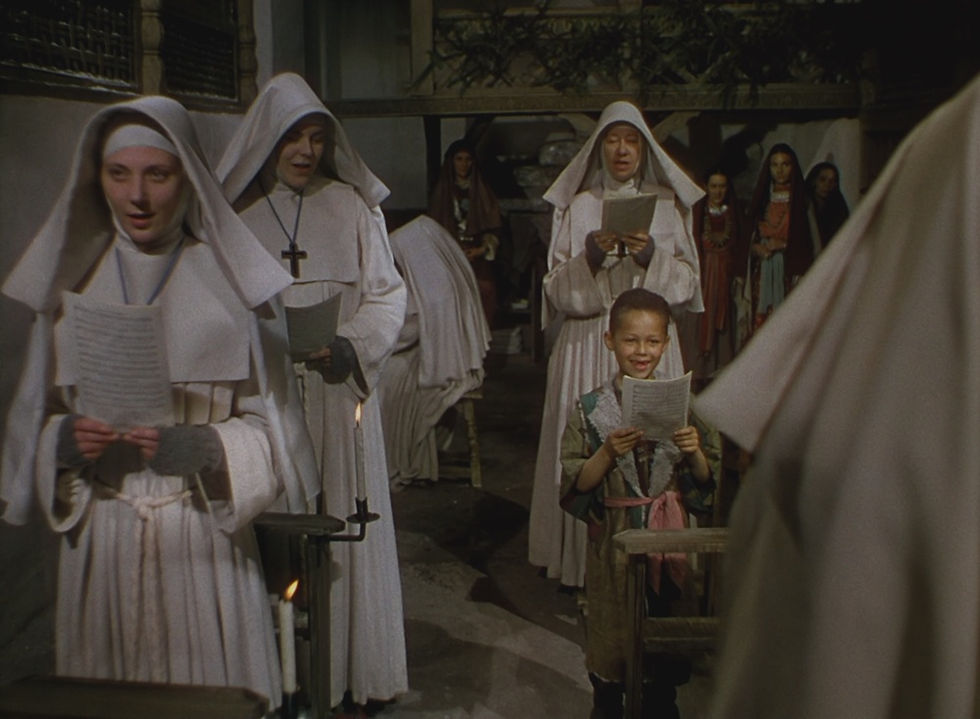Book Adaptations: Black Narcissus (1947)
- Samantha Glasser

- Aug 29
- 4 min read

Black Narcissus is the story of a cloister of nuns who are gifted the use of a palace in a remote part of India. They intend to turn it into a school, but resistance and superstition on the part of the natives and their own inflexibility in adapting to their environment makes the process more difficult than they expected. As time progresses the women slip farther away from their mission in various ways.

Author Rumer Godden was born in Sussex but grew up in India, and only returned to England for boarding school when she was a teenager, which she hated and never acclimated to. As an adult she returned to India and wrote about life there; her upbringing gave her work authenticity.
The film mostly uses the last 100 pages of the novel, which are the most exciting. It cuts down our perception of how much time has passed, but the edits maintain the action. It is a faithful adaptation in many ways, though there are minor changes.

In the book, Ruth is immediately painted to be highbrow and selfish, showing familiarity with extravagance and expecting special concessions. It pits us against her. The film opts to make the viewer suspicious of her simply because she resists taking orders from the Mother Superior (Deborah Kerr). Kathleen Byron is excellent in the part. I enjoyed that she and Kerr looked similar, but were like opposite sides of a coin. Byron’s transition into madness is enhanced by excellent makeup and costuming and heavy use of the color red. Director Michael Powell said that Kerr was like a radio who could pick up the ideas in his mind and perfectly interpret them for the screen.

Jenny Laird is an excellent pick to play Sister Honey. Her round, smiling face makes her instantly appealing the way the character is described in the novel. Ayah is larger-than-life and nasty in May Hallatt’s hands, an improvement over the book where she is simply slovenly. Jean Simmons is gloriously beautiful as Kanchi, what would have been a controversial casting choice in today’s world, but which works well for the film. She slinks around behind partitions, writhing and flirting while wearing extravagant jewelry including a few large nose pins.
I pictured someone like Sam Elliott for Dean, but David Farrar has only a fraction of his swagger. Directors Powell and Pressburger used costuming to show how his presence became an increased temptation to the nuns. He is introduced in noticeably short shorts and by the end of the film he is completely shirtless.

One thing that didn’t work in the transition between page and screen was the casting of the General and Con. Sister Clodagh joined the convent because the man she believed she would marry decided to go to America without her. (In the film she elaborates that she gave herself to him, enhancing his betrayal. “I had shown I loved him.”) She finds herself drawn to the General because he reminds her of Con, although she admits they look nothing alike. However, I expected them to have similar mannerisms or personas. Casting chose a traditionally masculine actor for Con, Shaun Noble, who resembles Mr. Dean more than the General. Sabu plays the General with youthfulness, grace and humor which are completely opposite Con.

There are touches of humor in this mostly serious film. I laughed out loud when the General said, “May I congratulate you on the birth of Christ?” at the Christmas service.
In the book, the death scene is vividly described, where in the film we do not see the body, only a shot of bamboo stalks in transition to suggest its final resting place.
The Catholic Legion of Decency condemned Black Narcissus, so the filmmakers made a point to make the nuns Anglican. After cuts and alterations, the Legion of Decency changed the rating to unobjectionable for adults, but although the censor board passed the film, some cities banned it, like Worchester, Massachusetts. Gossip columnist Louella Parsons said, “It's a beautiful picture, but I don't care for the theme.”

Motion Picture Herald’s reviewer said, “Black Narcissus is a typically British picture. Its action develops logically, but slowly. In some parts it is intensely dramatic. In others it drags. Then, also, some patrons may object to the treatment of the subject, which stresses the slow disintegration of discipline and the loss of faith within the group as a result of circumstances which finally result in the failure of the mission.”
Modern Screen’s reviewer wrote, “Life in a convent may not sound like exciting picture material, but this is a very unusual convent… Events move swiftly then to a climax, which solves nothing.”

Herb Lightman wrote in American Cinematographer, “Cinematographer Jack Cardiff, A.S.C., has broken a good many of the rules in trying for effects which the experts insist cannot be achieved in Technicolor. His use of low-key lighting is especially good, and somewhat unique in that he uses little or no fill lighting in such sequences. His angles are fresh and original — perfectly suited to the action of the scene.”
Cardiff won the Academy Award for cinematography, and Alfred Junge won for art direction; Jean Simmons accepted the awards on their behalf at the ceremony. The film heavily relies on artificial backgrounds, which gives it a unique artistic look. Junge’s team used black and white photos that they painted for vibrancy. Indeed, the scale of the mountain far surpassed my imagination. The palace is more sprawling and more scandalously decorated than I pictured too.
The novel and the film have their own independent merits, but fans of one will not be disappointed by the other, an unusual accomplishment for a beloved book adaptation.





Comments